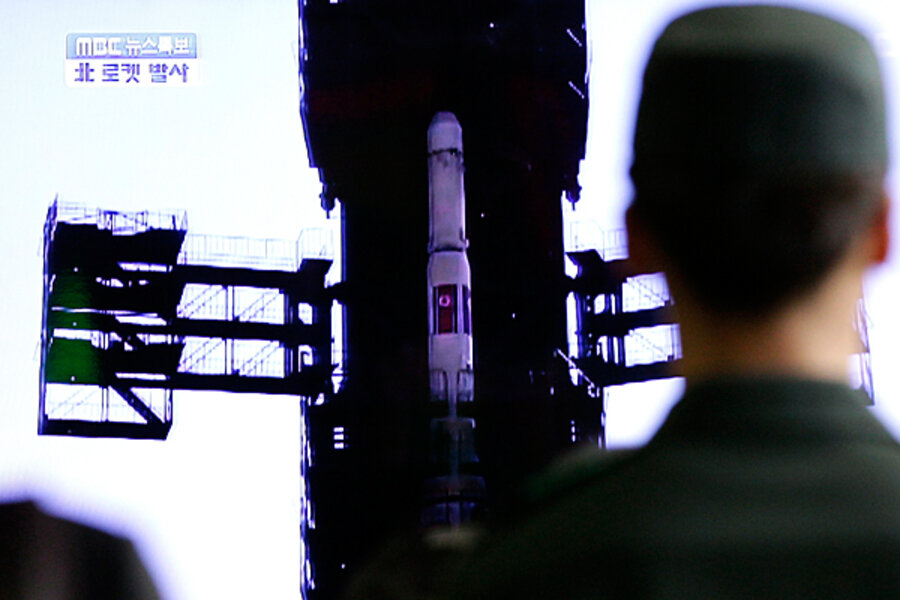In rare move, North Korea admits to missile failure
Loading...
| Seoul, South Korea
The failure of North Korea’s long-range missile fueled fears today that the North may conduct its third underground nuclear test in the near future.
Just hours after the missile plunged into the Yellow Sea, North Korea acknowledged the satellite said to be attached to the missile had “failed to enter its preset orbit.” Still, analysts questioned whether the missile actually carried a satellite. The clear purpose, they say, was to improve its capability to carry a warhead as far as the US West Coast.
The nature of the announcement, in the build-up for massive ceremonies marking the centennial Sunday of Kim Il-sung’s birth, suggests to analysts that North Korea’s policies remain unchanged – and that more missile tests, as well as another nuclear test, are likely.
The fact that North Korea acknowledged any level of failure came as a surprise – though the announcement on North Korea’s State TV network, by a woman wearing traditional Korean “hanbok” dress, did not reveal that the rocket had plunged into the sea slightly more than a minute after launch. The only detail offered was that assorted “scientists and engineers” were looking into the reasons for the “failure.”
“The implications are the same,” says L. Gordon Flake, director of the Mansfield Foundation in Washington. “Just because the test failed,” he says, does not enhance “the credibility of negotiators.”
North Korea's carefully phrased admission is likely to have been forced by the presence of foreign journalists, invited to Pyongyang to “witness” the launch. They first learned about the launch and, minutes later, about the failure, by phone calls to their home offices.
After the North Korean announcement, journalists were bussed to a ceremony for the unveiling of statues of KimIl-sung, the founding “great leader” who was born 100 years ago this Sunday, and his son, Kim Jong-il, who took over after his father’s death in 1994 and died last December. Kim Jong-il’s son and heir, Kim Jong-un, was at the center of leaders ranged in front of the statues, facing a throng of several thousand cheering people.
The US, South Korea, and Japan all denounced the launch as a violation of UN sanctions imposed after North Korea test-fired an earlier version of the same type of missile in April 2009 and six weeks later conducted its second underground nuclear test. The UN Security Council, meeting today, was expected to condemn the latest missile test even though China, the source of almost all North Korea’s fuel and much of its food, might oppose strengthened sanctions while calling for “peace and stability” on the Korean peninsula.
The question, says Mr. Flake, is “Does North Korea have greater pressure to go ahead with a nuclear test?”
The logic here is that Kim Jong-un, in his late 20’s, needing to consolidate his power, may now need to overcome the embarrassment of failure by demonstrating North Korea’s prowess as a nuclear power.
Flake cites the Spring 2009 missile launch and subsequent nuclear test as a disturbing precedent “for them to do these things in pairs.”
Analysts note, moreover, that North Korea may well respond adversely to criticism by the UN Security Council even if the Chinese response is weak. North Korea in effect has made clear, says Flake, “If you criticize our right to do a satellite, we will do a nuclear test.”
Scott Snyder, Korea expert at the Council on Foreign Relations in Washington, believes, however, that North Korea will need to come up with “a justification” for a nuclear test to convince those in sympathy with the regime’s sense of isolation and encirclement by hostile powers.
One sure sign of where North Korea is going on the nuclear issue is whether the International Atomic Energy Agency is able to send in inspectors as agreed in talks in Beijing between US and North Korean negotiators in February. That whole deal has collapsed as a result of the missile test, but the possibility remains that IAEA inspectors may visit the North’s main nuclear complex.
“They won’t see facilities elsewhere,” says Mr. Snyder, “but laying eyes on that facility might tell us more about the state of uranium enrichment” of nuclear devices.





